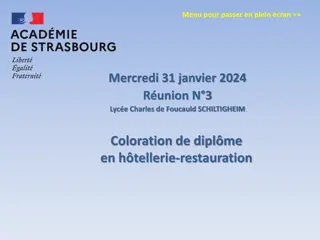Exploring Narrative and Simulation in Interactive Dialogue
In this discussion, Emily Short delves into the convergence of narrative and simulation within interactive dialogue, emphasizing goals like explorability, expressiveness, pacing, and character agency. The design focuses on player freedom in dialogue interactions while maintaining a compelling narrative experience.
Download Presentation

Please find below an Image/Link to download the presentation.
The content on the website is provided AS IS for your information and personal use only. It may not be sold, licensed, or shared on other websites without obtaining consent from the author. Download presentation by click this link. If you encounter any issues during the download, it is possible that the publisher has removed the file from their server.
E N D
Presentation Transcript
Narrative and Simulation in Interactive Dialogue Emily Short @emshort http://emshort.wordpress.com
Blood & Laurels Cults, prophecies, poison, intrigue. Imperial tropefest.
Prior Work Choice-based, running on Versu engine Parser-based interactive fiction
Conversation Design Goals Explorability: Player is free to explore dialogue space
Conversation Design Goals Explorability: Player is free to explore dialogue space Expressiveness: Player and NPC can signal emotional states as well as information
Conversation Design Goals Explorability: Player is free to explore dialogue space Expressiveness: Player and NPC can signal emotional states as well as information Pacing: story moves forward on its own when the player is out of things to say
Conversation Design Goals Explorability: Player is free to explore dialogue space Expressiveness: Player and NPC can signal emotional states as well as information Pacing: story moves forward on its own when the player is out of things to say Characters appear as entities with convincing emotional states Player agency involves manipulating characters Player responds to characters in non-utilitarian way
Tool Goals Authoring Easy to generate large quantities of content, at least 10x as much as the player is likely to encounter in a single play-through Easy to revise content once created
Tool Goals Authoring Easy to generate large quantities of content, at least 10x as much as the player is likely to encounter in a single play-through Easy to revise content once created Testing Easy to verify that there are no stuck states from which dialogue cannot proceed
Threaded Conversation Quips represent actual lines of non-repeatable dialogue ( The Emperor is looking ill these days ) Quips are tagged with one or more topics Relations between quips (direct and indirect following) Factual and emotional data associated with quips Prerequisites Outcomes
Blood & Laurels Versu AI engine + Threaded Conversation dialogue model More about Versu at versu.com
Project-Specific Goals Large story with many relationship configurations Multiple ways of enacting the protagonist role Richly branching narrative, high variability within scenes
Project-Specific Goals Large story with many relationship configurations Multiple ways of enacting the protagonist role Richly branching narrative, high variability within scenes 90-120 minutes of play time per complete reading
Project-Specific Goals Large story with many relationship configurations Multiple ways of enacting the protagonist role Richly branching narrative, high variability within scenes 90-120 minutes of play time per complete reading Accessible, book-like style High-stakes thriller plot Numerous achievements for the player to unlock
Project-Specific Goals Large story with many relationship configurations Multiple ways of enacting the protagonist role Richly branching narrative, high variability within scenes 90-120 minutes of play time per complete reading Accessible, book-like style High-stakes thriller plot Numerous achievements for the player to unlock Finished, illustrated, and ready for QA in 2 months
Areas of Assessment Authorability (speed, scope) Pacing/Narrative Coherence Agency based on Social Physics Character Persuasiveness / Empathy
Library Development: TC Threaded Conversation- style dialogue marked up for Versu to indicate emotional content and social actions Conversation Interrogate Artus about cult (tagged be_assertive) Tell Artus about the Emperor Other Social Practices Flatter Artus Pose assertively
Library Development: TC Topic-specific exposition ( memories ) Filler dialogue relating to various topics that appear in a number of scenes Pause text for when the conversation thread had been dropped and we want to allow a transition
Library Development: Scenes Exploration scenes end when the player has either explored dialogue or stopped doing dialogue exploration Forking scenes end in several ways when specific things are achieved Key decision scenes very short decision points with focused interaction
Tools Development: Prompter Developed with Graham Nelson, creator of Inform Tool for creating Threaded-Conversation- style content in a familiar screen-play like format
Artus (very disloyally): The Emperor is a tyrant and a madman. His appetites are disgusting, his use of Imperial troops misguided, and even his taste in dress is not above reproach. Someone will kill him sooner or later. I would prefer that his replacement not be another mad tyrant. (a) Marcus: His taste in dress...? -- Ask what is wrong with the Emperor's clothes Artus: He wears tassels on his leg, like a gladiator, to mark how many great men he has defeated. Gold tassels for men of the senatorial class, silver for equestrians. (b) Marcus: I see how it might displease you to watch the Emperor make blunders with the army. -- Sympathize with Artus's dislike of seeing the troops misused
Finished Product Stats 2503 quips in ep 1, 2460 quips in ep 2: roughly 10x the content of Galatea or Alabaster 172 scenes in ep 1, 238 scenes in ep 2 240K words of Prompter script Automated testing to discover scenes which did not conclude for some reason
Ease of Authoring Content Successes Rapid creation process Strong sense of flow Considerable variation within a scene Problems Rotating agent responsibility in Versu made some dialogue bits inaccessible without hacking
Pacing and Plot Coherence There s a great deal of room here to affect the pacing of a scene [it offers] a wealth of tonal interactivity and allowance for subtle performance PocketTactics
Pacing and Plot Coherence There s a great deal of room here to affect the pacing of a scene [it offers] a wealth of tonal interactivity and allowance for subtle performance PocketTactics Blood & Laurels made me feel more like an improviser than a reader New York Times
Pacing and Plot Coherence There s a great deal of room here to affect the pacing of a scene [it offers] a wealth of tonal interactivity and allowance for subtle performance PocketTactics Blood & Laurels made me feel more like an improviser than a reader New York Times The interface gives a sense of kinesis to the story something is always happening... the story is about being swept up in events much larger than yourself and attempting to gain control of them. -- Storycade
Pacing and Plot Coherence Successes Pacing generally successful Problems Juxtapositions of dialogue and setting investigation occasionally surprising Occasionally a player did not understand why a piece of dialogue became unavailable again; prototyped Versu Galatea UI addressed this
Characters and Agency When it works, it works. There are dinner parties where people will think you impetuous and rude if you talk too much, situations where you can act dumb in order to influence others to drop their guard, times where you have a choice between the same action with different motivations. Storycade
Characters and Agency When it works, it works. There are dinner parties where people will think you impetuous and rude if you talk too much, situations where you can act dumb in order to influence others to drop their guard, times where you have a choice between the same action with different motivations. Storycade But: [Veronius ] relationship with Marcus doesn t do much to affect the plot of Blood and Laurels. -- PocketTactics
Characters and Agency Successes Ability to see character thoughts and expressions helped Pushing your luck as a play experience was often satisfying Problems Players did not always understand how character manipulation drove scenes
Character Persuasiveness Versu isn t at the point where it s able to make this emergent behavior interesting to read. The most obvious is in the realm of romance... all of them feel fairly perfunctory in execution The vast, vast majority of Blood and Laurels s passages the ones directly under the author s control are wonderful. The emergent bits feel like static. Storycade
Character Persuasiveness [On occasion, t]he stars aligned such that the prose and the choices meshed in such a way that I felt I experienced a text holodeck . However, I m fairly certain the parts I felt inspired by were heavily scripted. When Versu as an engine clearly took over it hit solid as a rock. -- Jason Dyer
Character Persuasiveness Problems Players rebelled against the reuse of repeatable bits of conversation Some social practices (flirtation, anger) felt too generic
Design Issue! Too systematic? Not systematic enough? Some social practices (flirtation, anger) felt too generic Players did not always understand how character manipulation drove scenes
Possible Future Solutions Modeling narrative values explicitly in utility scoring Multiplicative rather than additive approach to conversation and other social practices More abstract visual clues for the player about narrative progress
Multiplicative Approach Additive Multiplicative Conversation Sycophantically tell Artus about Emperor Ask Artus about cult Flatteringly ask Artus about cult Tell Artus about the Emperor Assertively tell Artus about Emperor Other Social Practices Flatter Artus Assertively ask Artus about cult Pose assertively
Communicating Plot Position Explicit but abstract visualization of possible endings for the current scene & how close NPCs are to committing to one of those endings
Communicating Plot Position Explicit but abstract visualization of possible endings for the current scene & how close NPCs are to committing to one of those endings
Concluding Questions If we re modeling multiple kinds of system (narrative, agent relationships and emotions, conversation flow, protagonist intentions), which of these is most directly accessible to the player?
Concluding Questions If we re modeling multiple kinds of system (narrative, agent relationships and emotions, conversation flow, protagonist intentions), which of these is most directly accessible to the player? Does the player understand how these systems fit together? Does the UI support that understanding?
Concluding Questions If we re modeling multiple kinds of system (narrative, agent relationships and emotions, conversation flow, protagonist intentions), which of these is most directly accessible to the player? Does the player understand how these systems fit together? Does the UI support that understanding? Which offers the highest fidelity? Are other, lower- fidelity systems providing output in the same channel?























